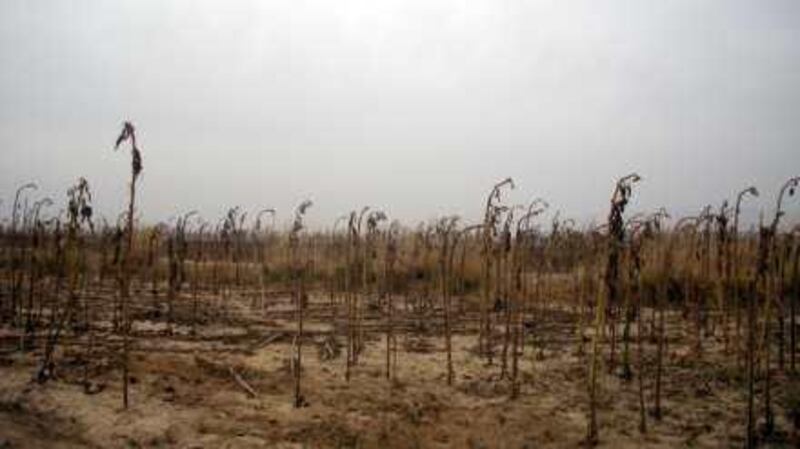BEIJING // Chi Li Lai slowly unloads his cart. He has just a few things left to move to his new apartment: an old vase, a broken table, a few pipes and a bag full of his past life. His wife and mother help him, both of their faces covered with scarves to fight off the first winter chill but especially to fend off the sand blowing in from the nearby Kubuqi desert. Mr Chi is one of 450 farmers being relocated from his hometown Duguitala, on the banks of the Yellow River, to what is now referred to as the "immigrant compound", 4km away. He was the victim of a flood last March that wiped out his house and many others when a dam was breached by high waters, The flood, experts say, was caused by climate change, which is wreaking havoc on the environment of Inner Mongolia, a province in northern China, and the Yellow River basin.
"The waters came in fast," said Mr Chi. "Ten metres high and 4km inland. I had time to run, but the animals did not. They all died; more than 100 sheep and my hens." He said he will never return to his life as a farmer and has traded the 300 square metres of land on which he and his family lived with their animals to a 70-square metre apartment on the second floor of a new blue and red building, which stands out against the desert dunes.
While Mr Chi blames human error for the flood, saying the dam that was breached on the Yellow river was not well-maintained, Marco Gemmer of the China Meteorological Administration pointed to heavy rainfall in the spring and the melting of the glaciers at the source of the river as the likely causes. "There was probably an ice break-off upstream which generates floods downstream," he said. Climate change is having a significant impact on the Yellow River and those who live along it - 300 million people, roughly one third of China's population.
According to the CMA, temperatures in Inner Mongolia are likely to rise by 3°C to 4°C in the next 50 years and the glaciers in the Himalayas are receding by around seven metres a year. "Global warming will accentuate peak climate patterns - more heavy rain and longer dry spells. We also estimate that the [Yellow] river's debit [the rate of flow of the water in the river] will not grow as fast as industrial demand and population pressure. All this will make things worse," said Mr Gemmer.
On top of that, Inner Mongolia, which is already two-thirds covered in sand, also has to cope with desertification, a process that imperils the fragile local ecosystem of the Mongolian grasslands - or what is left of them. Sand storms are just part of Mr Chi's life, beginning in spring and not ending until autumn. Locals see the encroaching Kubuqi desert, with its beautiful yellow dunes, as a curse, and stopping its progress is essential to agriculture and livestock, the backbone of the economy.
Ironically, the growth of local agriculture actually contributed to the desertification that now threatens it. "Livestock has doubled over the past 30 years in the province", said Mr Gemmer. "This has degraded the land." The disturbance of rainfall patterns, caused by climate change, is a major cause of the desertification and poor harvests, Mr Gemmer said. Rains are now coming in the winter months, when farmers have already harvested their crops, and not during the months when they are needed. The region only gets up to 150mm of rain a year.
"Thirty years ago, crops depended much less on the river, there was plenty of rain," said Mr Chi. "Now there is none." Mr Chi's new apartment overlooks a desolate landscape. Sand covers just about everything including the small trees planted last spring to block the advancing dunes. "Regularly crops get damaged by the sand storms," he said. Desertification costs China 54 billion yuan (Dh29bn) a year, according to the Chinese Academy of Social Science.
In 1978, the Chinese government launched a national plan to try to halt desertification, with much of it focusing on Inner Mongolia. Measures taken since then have included planting trees to strengthen the soil, placing branches on the dunes in a grid to hold the sand in place and - in the past five years - limiting the rearing of livestock, whose overgrazing dries up land, leaving it more vulnerable to desertification.
The hope is that desertification will no longer be a threat by 2058. Overall, the local government has planned to relocate 50,000 farmers to the area over the next few years. For Mr Chi, the March floods served as a convenient excuse for the authorities to move him away from agriculture as part ot their bigger plan. "Government policies have a human cost," said Mr Gemmer. "The legal framework to fight climate change and desertification are in place, but laws are sometimes difficult to apply."
Mr Chi has reared animals all his life and is somewhat lost without them. As part of his relocation he will be allotted a small piece of land in a communal green house to grow vegetables. The local government has paid for all of his new flat, which is just awaiting the installation of pipes and a water system before he can move in. "Of course I am not happy," the farmer says. "All I have now is a pension of 450 yuan a month to depend on."
@Email:foreign.desk@thenational.ae





